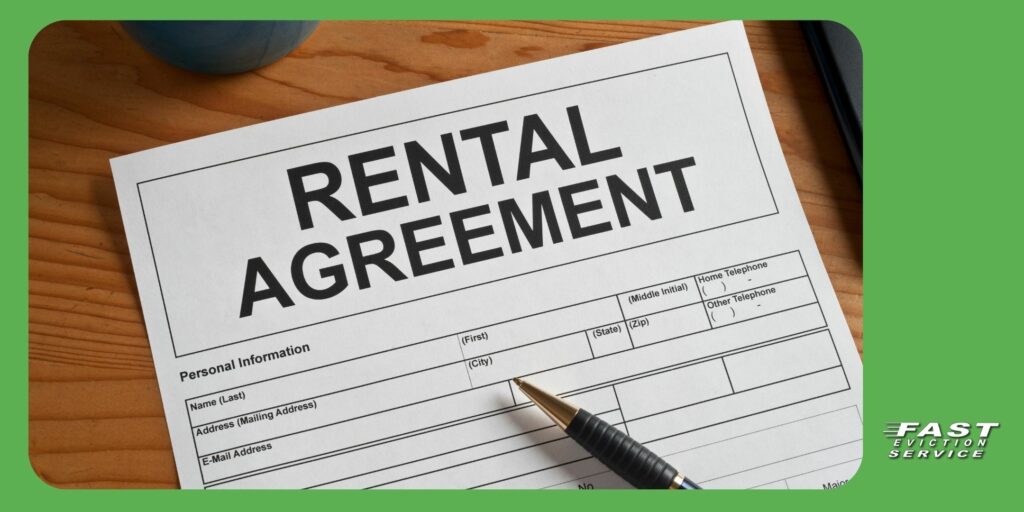You are represented at all times by one of our California Eviction Attorneys | 1-800-686-8686 | intake@fastevict.com | Se habla español
A Landlord’s Guide to Drafting a Basic California Rental Agreement
For California landlords, a basic rental agreement is more than just paperwork, it’s the foundation for a successful tenancy. A properly drafted lease clarifies responsibilities, sets expectations, and protects your property and income. Whether you own a single-family home or multiple units, understanding how to structure a solid lease can prevent misunderstandings and reduce legal risks.

Key Takeaways
- A clear, written lease helps landlords protect their property and reduce disputes.
- California law requires certain disclosures and limits on deposits, fees, and entry rights.
- Every rental agreement should include essential terms like rent, term, maintenance, and pet policies.
- Keeping your lease updated with state and local changes helps maintain compliance.
- A professional, consistent lease builds credibility with tenants and simplifies property management.
Table of Contents
- Why a Solid Rental Agreement Matters for Landlords
- Key Components of a California Rental Agreement
- Best Practices for Drafting a Landlord Lease
- Common Mistakes Landlords Should Avoid
- Legal Considerations for California Landlords
- Conclusion
Why a Solid Rental Agreement Matters for Landlords
A written lease gives landlords the strongest protection possible. It’s not just about collecting rent, it’s about ensuring the tenant understands and follows your property’s rules.
A basic rental agreement in California should cover every term of the tenancy in writing. This ensures compliance with California landlord-tenant laws, which require certain disclosures and protections for both parties. A well-structured agreement prevents ambiguity around payments, repairs, and behavior, making enforcement smoother when issues arise.
Additionally, written leases demonstrate professionalism and organization, key traits tenants notice when choosing housing.
Key Components of a California Rental Agreement
1. Identification of Parties and Property
List full legal names and contact details for both the landlord and all adult tenants. Clearly identify the property by street address and unit number to avoid confusion.
2. Lease Term and Type
Specify whether the agreement is month-to-month or a fixed-term lease (e.g., 12 months). Fixed-term leases offer stability, while month-to-month arrangements give flexibility. Landlords should choose based on turnover goals and property type.
3. Rent and Payment Details
Clearly state the monthly rent amount, due date, acceptable payment methods, and penalties for late payment. California allows late fees only if they are “reasonable” and listed in the agreement.
4. Security Deposit
California limits security deposits to one month’s rent, under AB 12 Landlords must return the deposit within 21 days of move-out, less lawful deductions for unpaid rent or damages beyond normal wear and tear.
5. Utilities and Services
Specify which utilities the tenant is responsible for. If you include utilities in rent, make this clear and specify any limitations. For multi-unit buildings, use a fair allocation system like RUBS (Ratio Utility Billing System) if allowed.
6. Maintenance and Repairs
State who handles repairs and routine maintenance. Landlords must maintain habitable living conditions under California Civil Code §1941. Tenants, meanwhile, should keep the property clean and notify landlords promptly of maintenance issues.
7. Rules and Restrictions
Define clear policies for pets, smoking, noise, guests, and subletting. Avoid overly broad restrictions, rules must be specific and fair to be enforceable.
8. Landlord Entry
Landlords may only enter with 24-hour written notice, except in emergencies. Include the allowable reasons for entry, such as inspections, repairs, or showings to prospective tenants.
9. Termination and Early Move-Out
Explain notice requirements, 30 days if tenancy is under one year, 60 days if longer. If tenants want to break a lease early, outline acceptable circumstances and fees (if permitted).
10. Required Disclosures
California landlords must include:
- Owner or manager contact information
- Lead-based paint disclosure (for pre-1978 units)
- Bedbug disclosure
- Flood risk notice
- Megan’s Law statement
- Notice if the lease was negotiated in another language (requiring translation)
Best Practices for Drafting a Landlord Lease
- Use clear, plain language to ensure tenants understand the terms.
- Customize your lease for each property instead of relying on generic templates.
- Attach addenda for special clauses, such as parking or shared utilities.
- Review city and county regulations, especially for rent-controlled areas like Los Angeles, San Francisco, or Santa Monica.
- Keep digital and paper copies of all signed agreements.
- Update your lease annually to reflect legal or policy changes.
A professional lease not only protects your investment but also promotes respectful tenant relationships and consistent cash flow.
Common Mistakes Landlords Should Avoid
- Failing to list all adult tenants by name.
- Leaving blanks or vague terms in the contract.
- Ignoring required disclosures or translation requirements.
- Charging excessive security deposits or illegal fees.
- Not defining maintenance responsibilities clearly.
- Using unenforceable “catch-all” clauses or outdated templates.
Each of these mistakes can make a lease invalid or difficult to enforce in California. Taking the time to review and update your agreement prevents major legal and financial setbacks.
Legal Considerations for California Landlords
California’s housing laws evolve frequently. Landlords must stay current on updates to deposit rules, rent limits, disclosure laws, and tenant privacy protections. Key statutes to review include:
- California Civil Code §1940–1954 (landlord-tenant obligations)
- Health and Safety Code §17920.3 (habitability standards)
- California Assembly Bills that affect rental terms or disclosure obligations
It’s important to ensure your basic rental agreement aligns with both state and local ordinances. When uncertain, landlords can consult professional property management or legal assistance for guidance, without this article constituting legal advice.
Conclusion
A carefully crafted basic rental agreement is one of the most valuable tools a California landlord can have. By clearly outlining responsibilities, complying with disclosure laws, and maintaining fair lease terms, landlords create stability, protect their investment, and build stronger tenant relationships.
Regularly reviewing and updating your lease will help ensure long-term compliance and peace of mind in managing your rental business.



